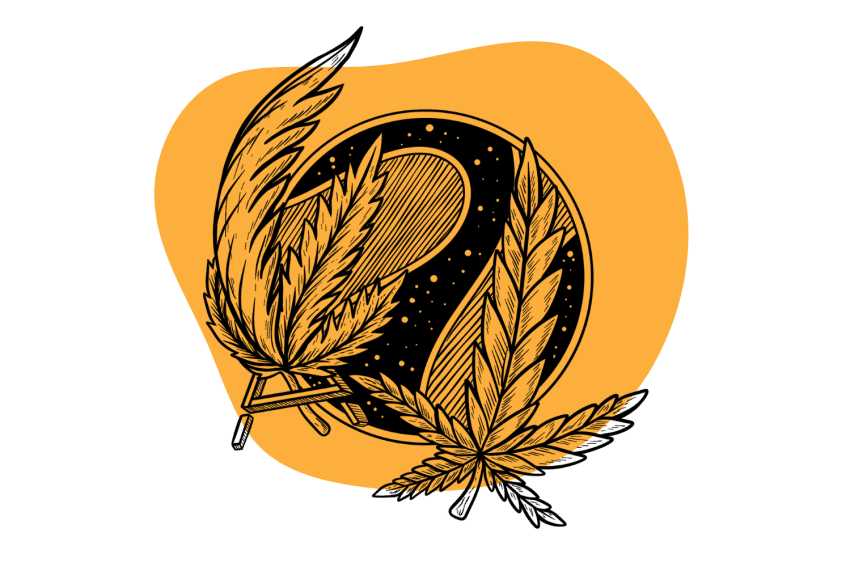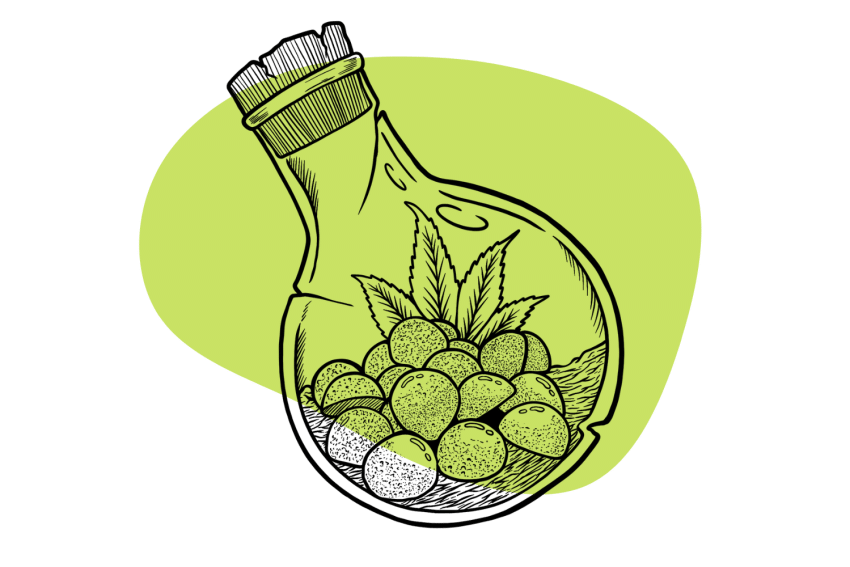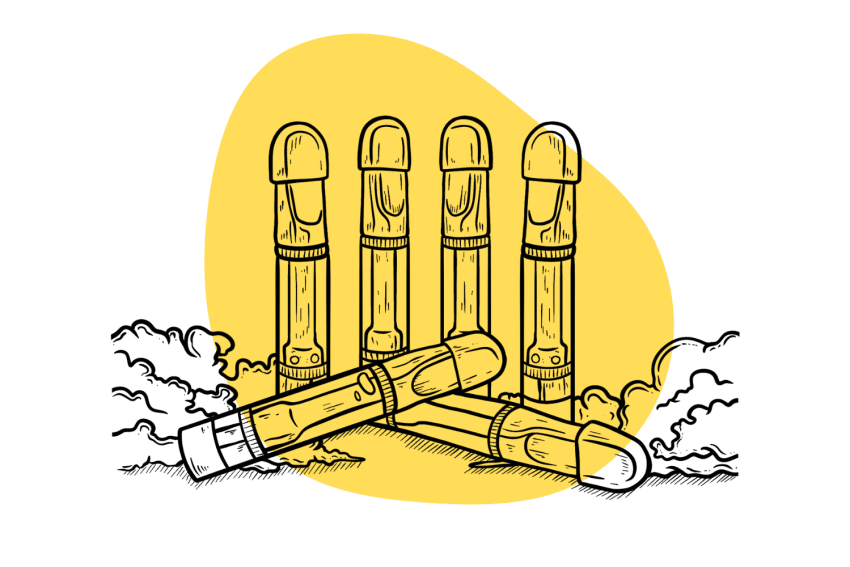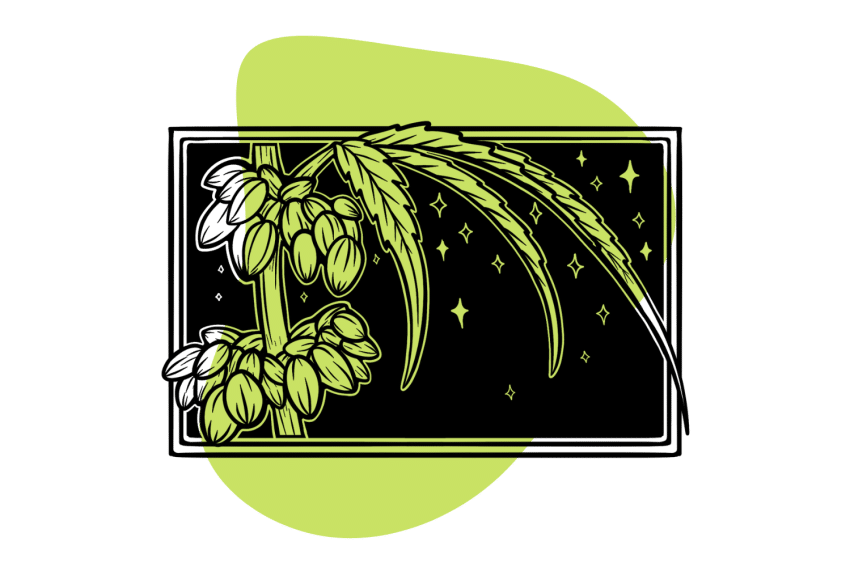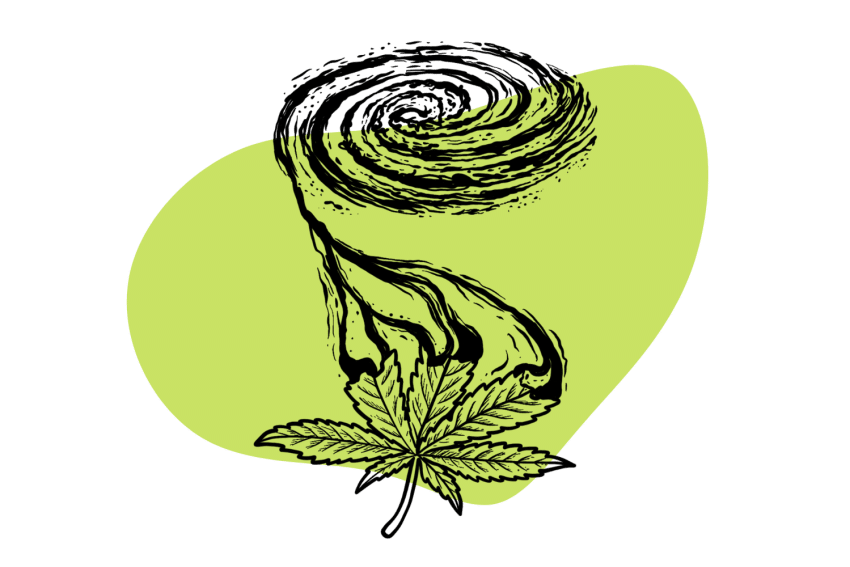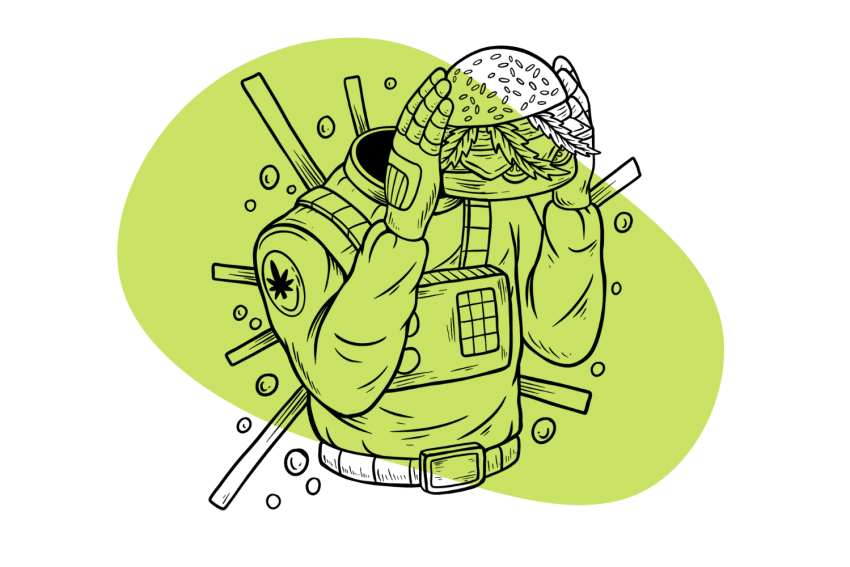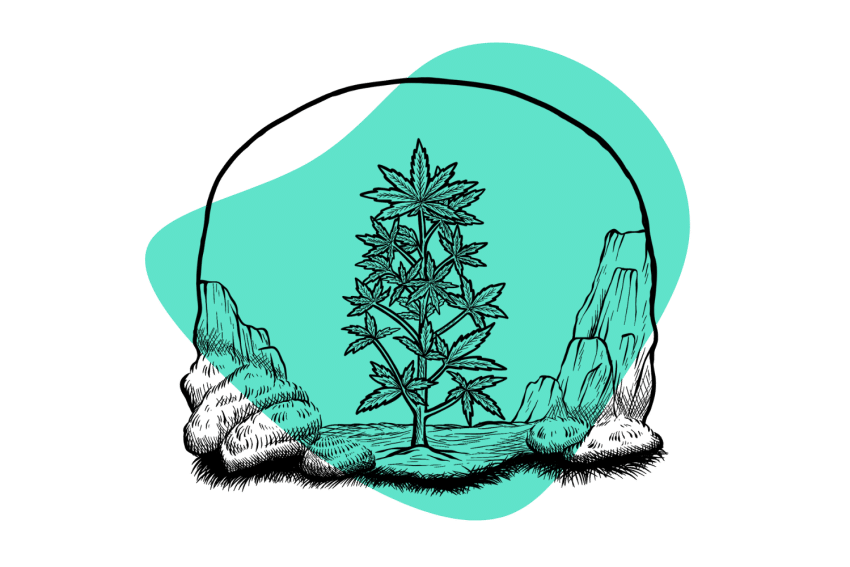THC Distillate Explained: Everything You Need to Know
THC distillates are an even more refined subtype of “cannabis concentrates.” Distillates are made by isolating individual cannabinoids through distillation.
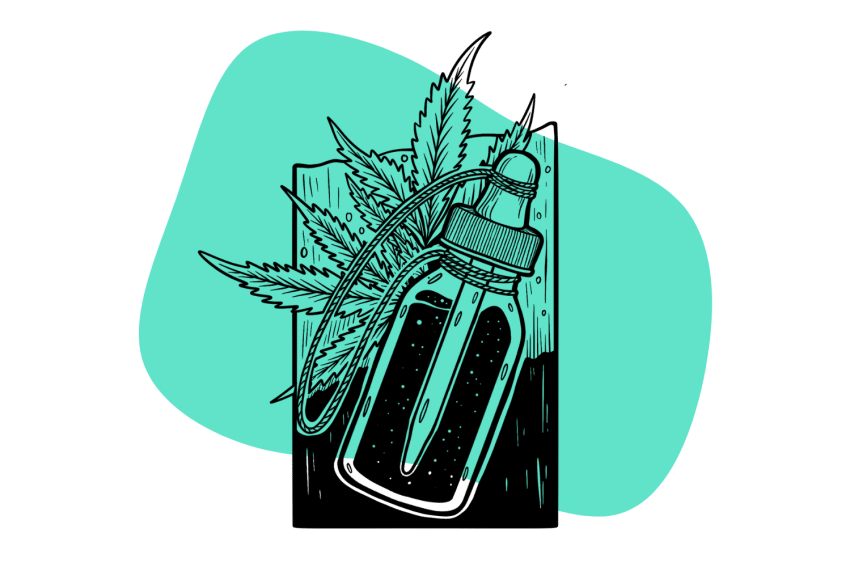
Distillation is a common process that we commonly think of for distilling alcohol from various natural sources. Whether it’s Kentucky moonshine or refining cannabis oil in a lab, the basics are the same — using temperature and pressure fluctuations to reduce the starting materials to a single component.
For cannabis, delta-9 tetrahydrocannabinol (THC) is the goal of distillation, and products typically exceed 90% in THC potency. Below, we’ll walk you through the entire process and what you should know before choosing your next (or first) THC distillate product.
Here’s a quick overview of what we’ll cover:
- What is THC distillate?
- Distillate vs. concentrates
- Distillate vs. raw flower
- How THC distillation works
- How to use THC distillate
- Side effects of THC distillate
As a potent form of THC, it can be dangerous to use distillate without a proper understanding of how to do so or dosage levels. Here’s everything you need to know to avoid unpleasant side effects:
What Is THC Distillate?
Distillates are slightly different from concentrates, refining higher levels of THC — at the expense of other terpenes, minor cannabinoids, and other supporting chemicals in cannabis flower.
This makes distillate a more potent option over concentrates but removes other potentially active components of cannabis in the process.
THC Distillate vs. Concentrates
As the name suggests, THC concentrates are products that pack larger amounts of THC into a smaller package. The process for making these can vary dramatically, and the potency for concentrated products can be between 50–90%.
Distillation methods regularly contain 90% or above THC content, leaving little room for CBD, terpenes, and other minor cannabis compounds. This increases the potency of the high but could push the experience into unpleasant territories.
Concentrates still contain fewer of the supporting compounds in cannabis than smokable flower, but several options strive to keep as many as possible. Distillation also distinguishes itself from concentrates through its more involved process and the complicated machinery it requires.
Distillation will always require solvents and a far lengthier process than a simple concentrate.
THC Distillate vs. Cannabis Flower
If you’re looking for a stronger high, distillates are the higher-potency option to blast through tolerance buildup or push the effect to another level. Higher levels of THC don’t always equate to a more enjoyable experience, however.
Additionally, without the support of other parts of the flower, the high can become overwhelming. Studies show that the best way to prevent anxiety and paranoia from THC is the addition of the non-intoxicating cannabidiol (CBD) to help round off the experience [1].
Cannabis flower contains over 140 cannabinoids and 1100 other compounds like terpenes, terpenoids, flavonoids, and more. While the stars of the show are the main cannabinoids, THC and cannabidiol (CBD), it’s likely the rest contribute to shaping the effect in some way.
In particular, terpenes are likely the major reason we consider different strains of cannabis to be more euphoric or sedative. These aromatic compounds are found in various other parts of the natural world, evaporating off and providing the smell and purported benefits of lemon, lavender, orange, and other essential oil products.
The endocannabinoid system (ECS) is a major pathway for maintaining balance across various functions. Cannabinoids interacting with it can have profoundly enjoyable or terrifying effects.
Overdosing on THC isn’t going to kill you, but it’s definitely not a fun experience. Make sure to approach distillates or concentrates cautiously if you aren’t already familiar with how THC can affect you.
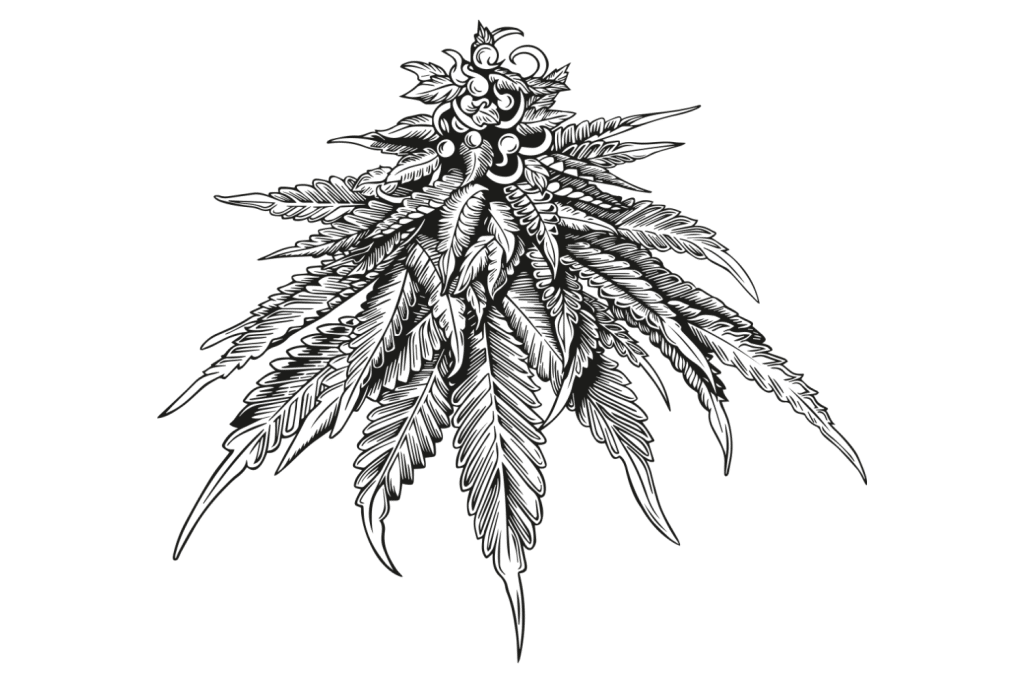
Step-By-Step: How Is THC Distillate Made?
Distillation processes can vary at several points, but the main process is as follows:
Step #1: Extract THC From The Cannabis Plant
Producers may start with a THC concentrate at this point or begin with the plant material itself. They will place it in a solvent to create a “crude oil” mixture to help break it down and isolate the THC further.
The 3 most common solvents are:
- Hydrocarbons (Butane Or Similar) — These compounds are excellent solvents used to strip away the cannabinoids, terpenes, and fatty compounds in cannabis. Required for making butane hash oil (BHO).
- Supercritical CO2 — Carbon dioxide is held under pressure and, at low temperatures, acts just like a solvent without needing toxic chemicals. Often used to make shatters, waxes, and live resins.
- Ethanol — Perhaps the first at-home method, this solvent is used to create Rick Simpson Oil (RSO)
Many of the solvents evaporate at low temperatures, so they’re easier to manipulate without risking damage from high heat.
Step #2: Cryogenic Ethanol Winterization
Producers then mix the extracts with ethanol in freezing temperatures — with the ideal being around -20°C/-4°F [2]. This helps to separate plant matter like lipids and chlorophyll as they solidify from the cannabinoids and terpenes, which do not.
Above these low temperatures, ethanol wouldn’t be a good option, as it will absorb cannabinoids along with all other parts of the plant. Within the “cryogenic” conditions, however, cannabinoids absorb into the ethanol and leave plant matter behind.
Step #3: Filtration & Evaporation
Once this process is complete, producers will filter out the residual plant matter from the solution. A proper winterization mixture will have “a translucent aspect with minor content of coloring compounds and other impurities.”
One of the benefits of ethanol is its low evaporation point, making it easy to remove with a careful amount of heat and movement. As the ethanol evaporates, it leaves the cannabinoid with a higher evaporation point behind it.
Step #4: Heating & Decarboxylation
Since the process all begins with raw plant material, it still contains the non-active acidic version of THC. Tetrahydrocannabinolic acid (THCA) is a precursor cannabinoid to delta-9 THC that is converted through heat and oxygen.
When smoking cannabis flower, this process happens rapidly through the flame of a lighter or high heat of a vaporization chamber. In this case, producers heat their raw THCA oil carefully to remove its carboxyl group (or decarboxylation) from the molecule, converting the THCA into THC.
Since the product will contain the active cannabinoid instead of its precursor, it is active through smoking, vaping, or eating without further preparation.
Step #5: Distillation & Refinement
After going through the rest of this process, the new oil full of delta-9 THC goes through an additional step of distillation to further purify the THC content. This typically involves heat and pressure to reach the different boiling points of various components of cannabis.
As producers work their way up in temperatures, they are ensuring unwanted compounds evaporate off and leave the cannabinoids behind. Afterward, some manufacturers go through additional refinement steps, though this isn’t strictly necessary.
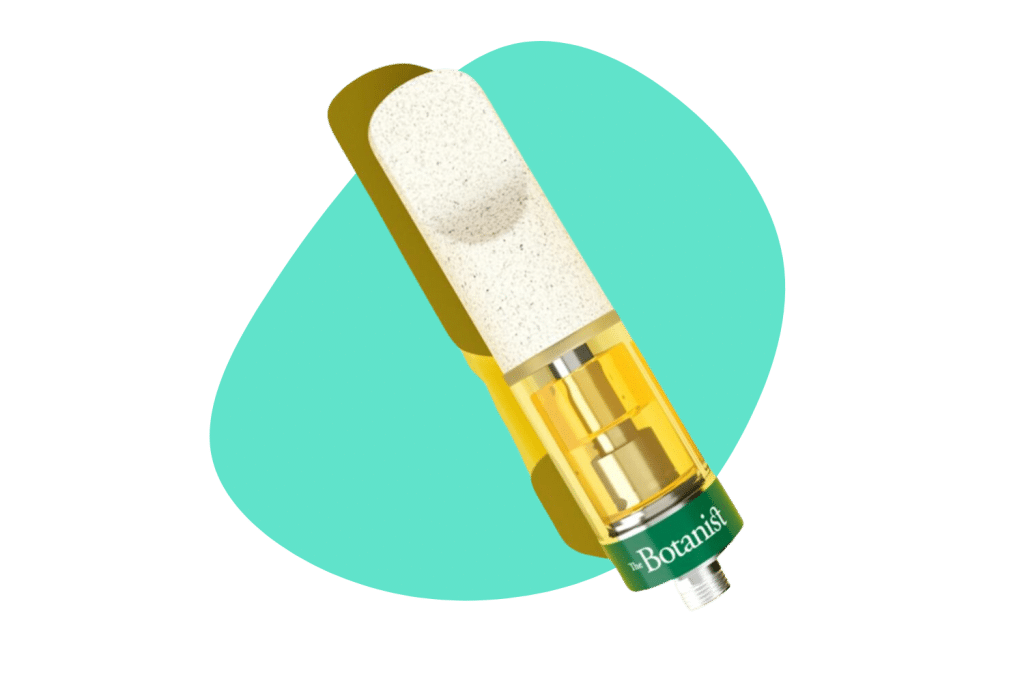
9 Features of High-Quality THC Distillate
Not all THC distillate is created equal — there’s a noticeable difference between the bottom-of-the-barrel extracts and top-shelf premium distillate.
Here are 9 key factors that impact distillate quality according to research [3]:
- Starting Material — Every strain of cannabis has a different chemical makeup and quality, which can impact how successful extraction is if manufacturers don’t take it into account
- Extraction Techniques — Some techniques are better and, therefore, often more cost- and time-intensive than others and can drastically improve or reduce the end result
- Duration of Extraction — While longer extractions may lead to better outcomes, it also increases the danger of burning off cannabinoids accidentally
- Pressure — Extraction methods with lower pressure levels may be less effective than others since it’s a key component of the process
- Temperature Of Process/Environment — Temperature is one of the main tools for distilling THCA and decarboxylating it into THC, and too much or too little heat can both impact efficacy
- Ratio Of Solvent To Plant Material — Too little solvent won’t be able to capture all of the cannabinoids of the plant, but too much can make it difficult to remove later
- Frequency And Quality Of Agitation — The plant material needs movement to help it break up, and it’s more likely to do so with movement
- Solvent pH Levels — Acidic cannabinoids tend to be more stable when in an acidic solution, but too much acidity can be detrimental
- Which Solvent You Use — Producers utilize a wide range of solvents, but some are less effective than others or require minor variations in processes
On a broader level, these break down into 3 main categories:
Quality & Understanding Of Starting Material
While distillate is a typical step for lower-quality crop yields, a premium flower will produce better distillate. Cannabis with higher yields of THC will create a higher yield of distillate by the value of having more yield.
Since cannabis can drastically vary in chemical makeup, distillation also requires manufacturers to understand the makeup of any raw flower they might use. You can’t strip away other cannabis compounds if you aren’t sure which ones you’re going after.
This is a large part of the reason why producers typically go for concentrated forms of THC or lower-quality cannabis flower. Concentrates remove a large part of the plant material already, and the lower-quality flower will still produce a pure distillate — albeit less — and will have less complex chemical considerations.
Extraction Process
Choosing the process, the environment it will be in, the solvents you will use, and various temperature/pressure conditions can severely impact quality. There are at-home distillation kits and major laboratories; it’s not hard to guess which produces a higher quality.
Some processes require explosion-proof rooms and other costly expenses beyond the machinery. Still, there are plenty of producers with a lot of money sunk into a lab without the staff or diligence needed to perfect the process.
You can’t make the highest-quality extraction without the best equipment — but the equipment alone doesn’t guarantee you’ll do so either.
Skill, Attention, & Diligence
Between agitation, temperature fluctuations, changes in pressure, and other variables, there are a lot of places for extraction to go wrong. It’s imperative to observe and adjust the processes, machinery, solvents, and more throughout manufacturing to maintain quality.
In the late 1800s, scientists discovered “red oil,” the first attempt at isolating THC from cannabis. Research was cut tragically short when one of the scientists involved in discovering it was killed in an explosion at the lab [4].
His colleague, haven taken a large dose of the oil out of boredom, “was found wandering aimlessly in the lab unable to stop giggling and repeating ‘this is lovely’ while flames were developing around him because oxygen had leaked into the distillation flask and set fire to diethylzinc.”
Many distillation processes are still dangerous, and it’s imperative to keep a close eye on it the entire time — which can be quite long. It may not be an explosion, but a lot can go wrong and impact or even ruin the entire batch.
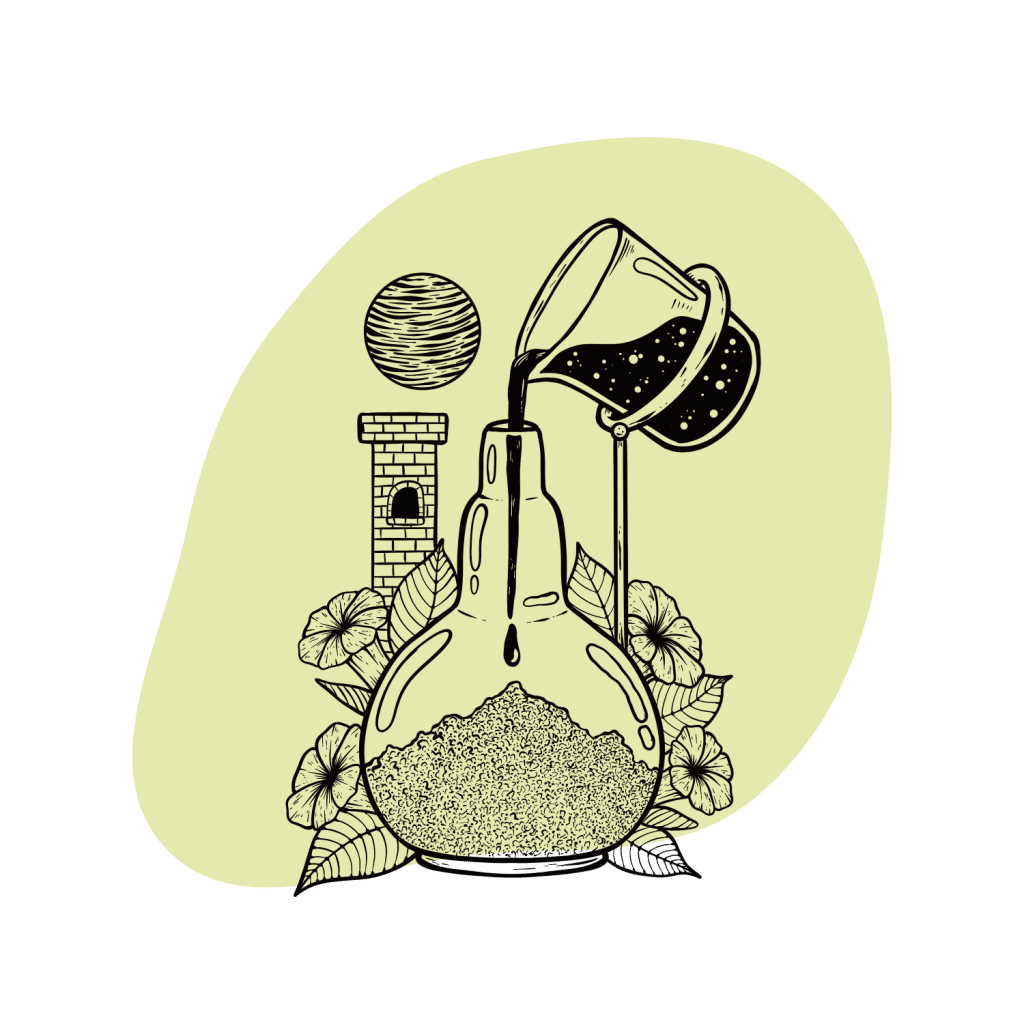
Advanced THC Distillate Manufacturing: Hydrodynamic & Ultrasonic THC Extraction
Two newcomers to the field of THC extraction and distillation are hydrodynamic and ultrasonic options. These use the force of water or sound waves along with temperature and pressure fluctuation to rapidly break apart the plant and extract cannabinoids in high quantities [5].
While research on the topic is scarce — and mostly revolves around proprietary secrets without much information — it seems this may also boost “bioavailability.” This means the body can absorb them better, resulting in higher efficacy and potentially even a longer duration.
This is a process that can begin with fresh cannabis flowers or as a refinement step for other distillation methods. In addition to increasing bioavailability, some companies claim it has a higher extraction rate than most other methods.
Of course, with that comes a hefty price tag that many producers are unwilling to pay, and there’s still very little we know about this method.
How To Consume THC Distillate
Since THC distillate goes through the step of converting THCA to THC, it’s incredibly versatile. Products typically package the distillate in a syringe for easy use, as well as small containers or cartridges for vape pens.
Here are some of the many ways you can use THC distillate:
1. Dabbing THC Distillate From A Bong or Rig
“Dabbing” involves vaporizing distillate at high heat and smoking it through a water pipe (or “bong”). While it’s a common practice for frequent consumers, the equipment it requires makes it less approachable for newcomers.
Dabbing distillate is likely the best way to achieve the strongest effect since the water cools the smoke down to enable larger hits at once.
What You’ll Need To Dab THC From A Bong:
Any bong can technically work for a dab as long as it has the specialized bowl along with some other equipment to do the job:
- Distillate or concentrate of your choice
- Bong (ideally with extra chambers or longer stem to cool the vapor down more)
- Specialized bowl with the airflow stem at the top and a bucket-like collector below (“banger” or “nail”)
- Topper for the nail to keep the vaporized distillate from escaping (“carb cap”)
- Butane torch lighter (a regular lighter won’t have enough heat)
- A dab tool (if the concentrate isn’t in a syringe)
- (Optional) Timer
- (Optional) Remote temperature checker
- (Optional) Glass beads to place inside the nail
How To Dab Out Of A Bong
If you’re looking to dab out of a bong, here’s the step-by-step:
- Add water to the bong and test it with some deep pulls to ensure it bubbles and doesn’t splash back
- Heat the nail (with beads in it if you have them) with the torch on the bottom and sides
- When the nail turns bright red, turn the torch off and wait 30–45 seconds or until it reaches a temperature of around 400–600°F
- Apply a small amount of distillate to the side of the hot nail and let it run off your dab tool completely while breathing in through the mouthpiece.
- After the distillate is in the bowl, top it with the carb cap to fill the chamber with smoke.
- Remove the carb cap to clear the smoke from the chamber when it’s full
- Continue until the distillate is no longer providing vapor
If you have glass beads in the nail, they will swirl around in circles as you breathe in to help distribute the heat across more surface area of the distillate.
Dabbing can be a messy practice, so it’s always a good idea to have a jar of ethanol and some Q-tips next to your rig so you can clean the nail out between uses. Some people also like to have a rubber “dab mat” to keep the messiness concentrated in an easy-to-clean area.
2. Topping Cannabis Flower With THC Distillate
A far easier practice for using distillate is to add a little boost to your cannabis flower. Keep in mind that this will create an extremely high effect, though it will be a less effective use of the distillate.
A typical lighter can create temperatures over 1,500 °F, which is far more than you’d need to vaporize distillate. As a result, THC may burn off, and you’re highly unlikely to get the same amount of bang for your buck.
However, this is an exciting way to add the terpenes and other minor components of cannabis back into the equation while punching up the THC content of your stash.
Tips For Smoking Distillate With Cannabis Flower
If you’re looking to up the wow factor on your bud by topping it with distillate, here are some tips for getting the most out of the practice:
- Sandwich your distillate between flower rather than putting it on top so it’s not exposed directly to the lighter and won’t run down the stem
- Hold the lighter as far away from the bowl as possible and try to light a single section away from the distillate so it’s exposed to the heat indirectly first
- Take slow, maintained hits to prevent the fire from burning too bright or taking over the whole bowl at once
- Try lighting it one last time after you feel the bowl is done to see if you can catch any residual distillate and prevent it from clogging up the bowl
- If you’re rolling a joint and including distillate inside of it, try to put it near the middle so it can receive heat from the front of the joint as it begins creeping down
- Don’t put distillate too low or too high in a joint (or include too much of it), or you may find it dripping out or clogging up the airflow
3. Vaping THC Distillate
Companies like Puffco have created electronic dab — this process from a bong also involves vaporization — devices with controlled temperatures. Additionally, cartridges and vape pens have become popular ways to discretely consume THC distillate among consumers.
Occasionally, dab devices will involve water chambers to cool the vapor down, but it’s more common for devices to vaporize, distillate, and deliver the vapor directly to you. This makes the inhale a bit harsher, making the large pulls possible when dabbing out of a bong impossible.
Still, it’s not everyone’s goal to take in as much THC as possible, so this is a go-to for several casual consumers.
What Temperature To Vape THC Distillate At
In general, higher heat will lead to more vapor at once, and lower heat will result in a better flavor and easier-to-handle inhale. Since every device is different, it’s best to check the specific guidelines, but, in general, 200–260°C (400–500°F) is a good sweet spot.
Distillate will begin vaporization as low as 150 °C (300°F), but this risks degrading the THC since it’s unlikely to vaporize as readily at this low of a temperature. At the high end, try not to exceed 315°C (600°F) if you’re looking for a stronger amount of THC at once.
Just remember this will be a harsher hit and will likely burn off most of any remaining terpenes before they can vaporize.
Sometimes, electronic dab tools require some pre-heating time, but others can reach the optimal temperature range within a minute or so. There’s no need to wait for them to cool down like you would if dabbing from a bong, so the process is a little easier with these as well.
4. Adding THC Distillate To Edibles
When infusing or baking edibles with flower, decarboxylation is a crucial first step to ensure your brownies are truly “special.” Since distillation involves the process of converting THCA to its active form, consumers can add it directly to any dish, baked good, or other edible treat.
The real problem with using distillate lies in its heavy potency and how easy it is to overdose your dish. Concern for this elevates when it comes to edibles since they have a longer-lasting effect and can result in several hours of paranoia and anxiety.
Underdose your first couple of attempts to work your way up to higher amounts, and take note of how much you’re using and how it affects you.
As the adage goes, you can always take more of an edible; you can never take less.
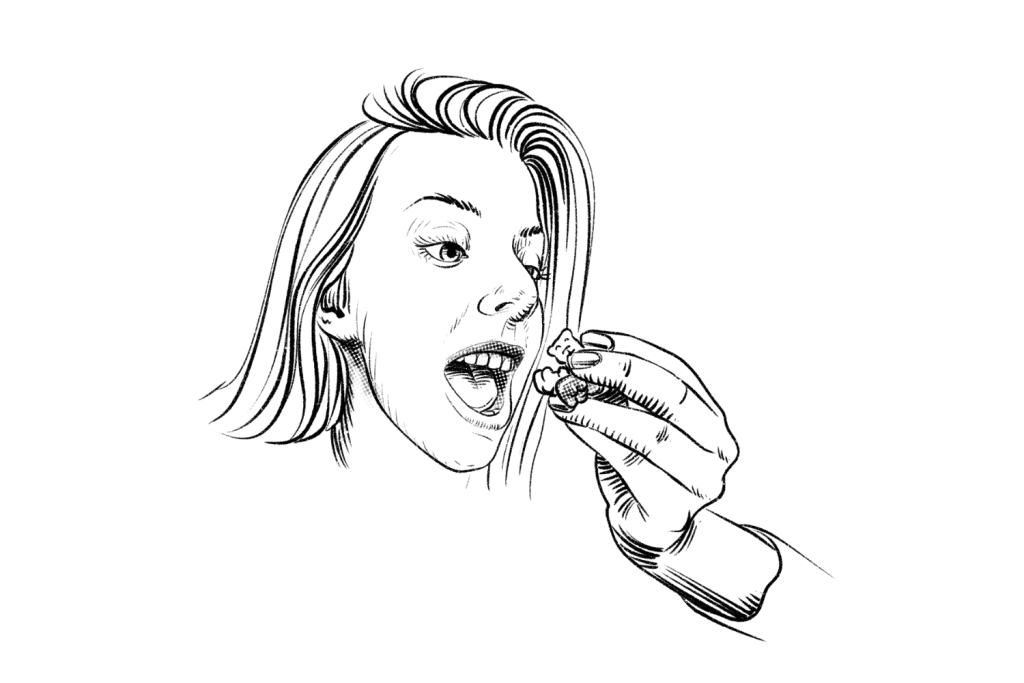
How To Dose THC Distillate Edibles
Since distillate is already active as-is, you could create edibles by simply adding your desired dosage on top of virtually any meal. If you already know your typical dose, you could multiply that by whatever number of edibles you’d like to spread it across; just make sure you don’t accidentally overdo it.
Here’s an example of how to figure out the correct amount of a 95% THC distillate to add if you want to bake 10 brownies with 20mg of THC each:
- 10 brownies X 20mg of THC = 200 total mg of THC for the tray
- 200mg of THC X 1.05 to account for the 10% that isn’t THC = 210mg
If you add 210mg of distillate to your tray of brownies and cut them into 10 equal pieces, each should contain 20mg of THC. If you want to infuse butter or oil to achieve the same effect, you can follow the same process but might want to familiarize yourself with how much your typical serving is beforehand.
Another concern with distillate is ensuring you spread it thoroughly into whatever you’re making to ensure it doesn’t clump together in a single bite.
Side Effects From Dabbing/Smoking THC Distillate
With distillate, you’re removing the potentially helpful CBD and increasing the potential to trigger an anxious response [6]. Studies have found CBD to have a calming effect on the THC high and can provide a more reliable level of calm euphoria as opposed to anxious paranoia.
Another concern is over the little-understood Cannabis hyperemesis syndrome (CHS) — a condition with episodes of “relentless vomiting, retching, abdominal pain, and neurological symptoms [7].”
While the actual trigger behind CHS or its episodic symptoms is uncertain, larger doses of THC likely enhance the potential of it developing. With a rapid tolerance buildup, consumers may continue taking in excessively high amounts of THC habitually without even realizing it.
Subscribe For More 🍄
References
- Englund, A., Freeman, T. P., Murray, R. M., & McGuire, P. (2017). Can we make cannabis safer? The Lancet. Psychiatry, 4(8), 643–648. https://doi.org/10.1016/S2215-0366(17)30075-5
- Toloza, H., Buitrago, O. Y., Orjuela, A., Santaella, M. A., Hurtado, A. M., & Arturo, D. E. (2024). Solvent extraction of Cannabis sativa under cryogenic conditions. Separation and Purification Technology, 329, 124906. https://doi.org/10.1016/j.seppur.2023.124906
- AL Ubeed, H. M. S., Bhuyan, D. J., Alsherbiny, M. A., Basu, A., & Vuong, Q. V. (2022). A Comprehensive Review on the Techniques for Extraction of Bioactive Compounds from Medicinal Cannabis. Molecules, 27(3), Article 3. https://doi.org/10.3390/molecules27030604
- The early history of cannabinoid research | Rendiconti Lincei. Scienze Fisiche e Naturali. (n.d.). Retrieved March 27, 2024, from https://link.springer.com/article/10.1007/s12210-020-00956-0
- Lazarjani, M. P., Young, O., Kebede, L., & Seyfoddin, A. (2021). Processing and extraction methods of medicinal cannabis: A narrative review. Journal of Cannabis Research, 3, 32. https://doi.org/10.1186/s42238-021-00087-9
- Henson, J. D., Vitetta, L., Quezada, M., & Hall, S. (2021). Enhancing Endocannabinoid Control of Stress with Cannabidiol. Journal of Clinical Medicine, 10(24), Article 24. https://doi.org/10.3390/jcm10245852
- Rubio-Tapia, A., McCallum, R., & Camilleri, M. (2024). AGA Clinical Practice Update on Diagnosis and Management of Cannabinoid Hyperemesis Syndrome: Commentary. Gastroenterology. https://doi.org/10.1053/j.gastro.2024.01.040

